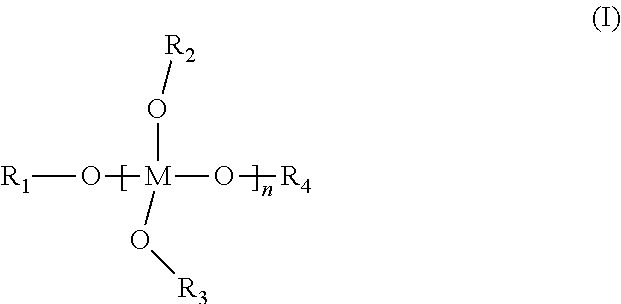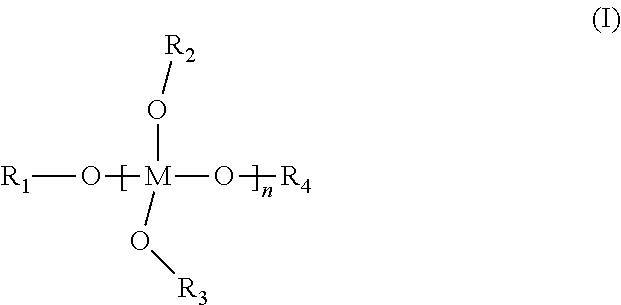Stable metal compounds as hardmasks and filling materials, their compositions and methods of use
a metal compound and hardmask technology, applied in the field of new soluble, multiligand-substituted metal compounds, can solve the problems of affecting the uniformity of radiation, affecting the stability of the material, and changing the critical line width dimension, so as to improve the stability
- Summary
- Abstract
- Description
- Claims
- Application Information
AI Technical Summary
Benefits of technology
Problems solved by technology
Method used
Image
Examples
synthesis example 1
[0060]40 g of Titanium(IV) butoxide polymer (Ti(IV)BTP polymer) (Sigma-Aldrich Corporation, St Louis Mo.), was dissolved in 52 g of 70 / 30 PGMEA / PGME solvent and poured into the reaction vessel under N2. This solution was stirred and its temperature raised to 50° C. while trimethylsilanol 12 g was added dropwise under N2. The reaction mixture was kept at 60 C for 2 hours, after which time 20 g of 1,2-cyclohexanedicarboxylic anhydride and 20 g of 70 / 30 PGMEA / PGME were mixed with the above reaction mixture and the reaction was continued at 60° C. for about one hour. After cooling down to room temperature overnight, the product was stored in a brown bottle and sealed carefully. FT-IR spectrum of the product solution was taken in cyclohexane. The resonance at 970 cm-1 was assigned to Ti—O—Si stretching frequency. The measured total metal oxide content was 28 wt % in films after baking at 150° C. for 60 s.
synthesis example 2
[0061]40 g of Ti(IV)BTP polymer was dissolved in 58 g of 70 / 30 PGMEA / PGME solvent and poured into the reaction vessel under N2. The temperature was raised to 50° C. while stirring and trimethylsilanol 18 g was added dropwise under N2. The reaction was kept at 60° C. for 2 hours. Then 20 g of 1,2-cyclohexanedicarboxylic anhydride and 20 g of 70 / 30 PGMEA / PGME solvent was mixed with the reaction mixture and the reaction was continued at 60° C. for about one hour. After cooling down to room temperature overnight, the product was stored in a brown bottle and sealed carefully. The measured total metal oxide content was 32 wt % in films after baking at 150° C. for 60 s.
synthesis example 3
[0062]20 g of Ti(IV)BTP polymer was dissolved in 25 g of 70 / 30 PGMEA / PGME solvent and poured into the reaction vessel under N2. The temperature was raised to 50° C. stirring while tertbutyldimethylsilanol 4.5 g was added dropwise while stirring under N2. The reaction was kept at 60 C for 2 hours. Then 5 g of 1,2-cyclohexanedicarboxylic anhydride and 5 g of 70 / 30 PGMEA / PGME solvent were mixed into the reaction mixture and the reaction was continued at 60 C for about one hour. After cooling down to room temperature overnight, the product was stored in a brown bottle and sealed carefully.
PUM
| Property | Measurement | Unit |
|---|---|---|
| Composition | aaaaa | aaaaa |
| Structure | aaaaa | aaaaa |
| Stability | aaaaa | aaaaa |
Abstract
Description
Claims
Application Information
 Login to View More
Login to View More - R&D
- Intellectual Property
- Life Sciences
- Materials
- Tech Scout
- Unparalleled Data Quality
- Higher Quality Content
- 60% Fewer Hallucinations
Browse by: Latest US Patents, China's latest patents, Technical Efficacy Thesaurus, Application Domain, Technology Topic, Popular Technical Reports.
© 2025 PatSnap. All rights reserved.Legal|Privacy policy|Modern Slavery Act Transparency Statement|Sitemap|About US| Contact US: help@patsnap.com



